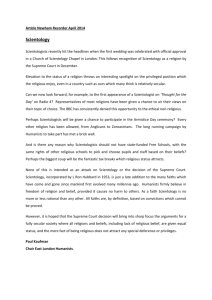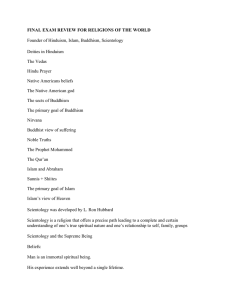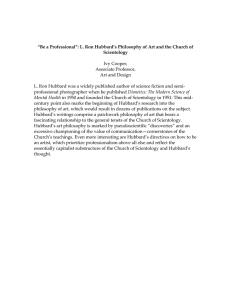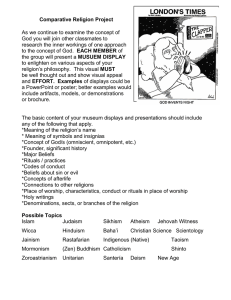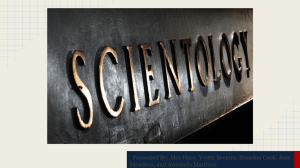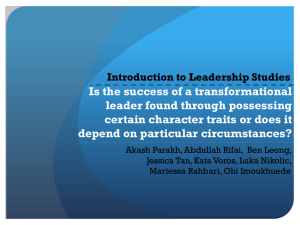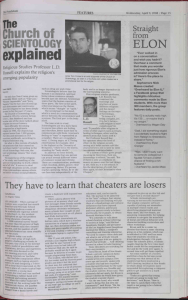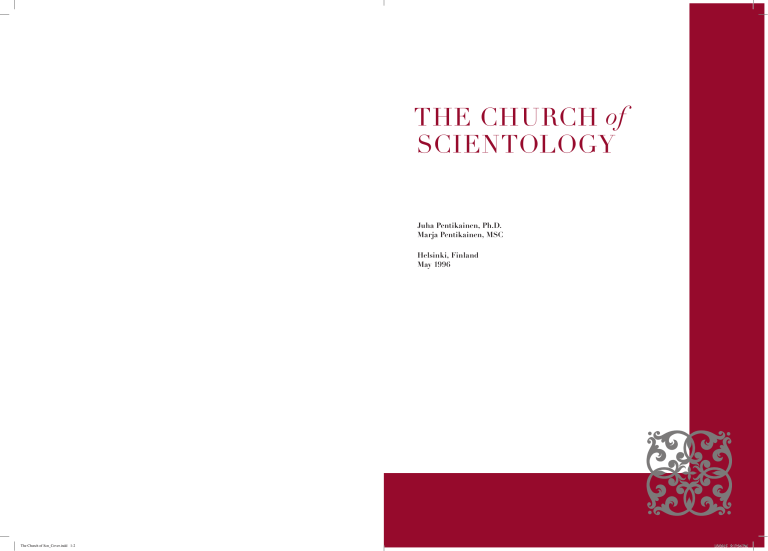
The Church of SCIENTOLOGY Juha Pentikainen, Ph.D. Marja Pentikainen, MSC Helsinki, Finland May 1996 The Church of Scn_Cover.indd 1-2 1/3/2015 5:17:34 PM The Church of Scn_Cover.indd 3-4 1/3/2015 5:17:34 PM The Church of SCIENTOLOGY Juha Pentikainen, Ph.D. Marja Pentikainen, MSC Helsinki, Finland May 1996 The Church of Scn_Bklet.indd 1 1/3/2015 4:03:23 PM The Church of Scn_Bklet.indd 2 1/3/2015 4:03:23 PM The Church of Scientology Contents The Church of Scn_Bklet.indd 3 Introduction 2 About the Concept of Religion 3 The Five Dimensions of Religion 4 The Religio-Philosophical Background of Scientology 6 A New “Book Religion” in Search of Orthodoxy 8 Scientologists’ Way of Ritual and Life Styles 9 The Role of Scientology in the Exchange of Religions 11 Scientology as a New Religion 11 A. Cognitive Dimension 12 B. Affective or Emotional Dimension 12 C. Conative or Behavioral Dimension 13 D. Social Dimension 13 E. Cultural Dimension 13 Conclusions 14 About Sources on Scientology 16 1/3/2015 4:03:23 PM The Church of Scn_Bklet.indd 4 1/3/2015 4:03:24 PM The Church of SCIENTOLOGY Juha Pentikainen, Ph.D. Marja Pentikainen, MSC Helsinki, Finland May 1996 This joint report has been written in January 1996 by Juha and Marja Pentikainen whose CVs are summarized below. Juha Pentikainen, Ph.D., is Professor and Chair of the Department of the Study of Religions, University of Helsinki, Finland, and the Institute of Social Science, University of Tromso, Norway. After having received his Ph.D. degree from the University of Turku in 1968 he was appointed to start the new discipline of the Study of Religions at the University of Helsinki in 1972. He has been a visiting professor of the Study of Religions, Cultural or Social Anthropology, Folkloristics and Scandinavian Studies in the Universities of California (Berkeley, Los Angeles), Texas (Austin), Minnesota (Minneapolis), Indiana (Bloomington) and Rome (Sapienza). He has been the Delegate of Finland in the United Nations and UNESCO and is the member and adviser of several work groups and committees nominated by the government and ministries of Finland. Juha Pentikainen has done field work in all the continents except South America and given lectures in more than 60 countries. In 1994 he was invited to initiate a new discipline and Department of Religious Studies at the Institute of Social Science in the University of Tromso. His more than 20 books, 350 articles and 10 films have been awarded with several international prizes and degrees. In 1995 he was nominated to the membership of Academia Scientiarum Fennica. Marja Pentikainen, MSC, is Executive Chief of the Foreigners’ Office of the City of Tampere. After having received her degree in Social Policy she is now proceeding to her doctoral thesis in the University of Tampere. She has been a social worker and is today chairing the office which she initiated in 1989. She is the lecturer of the Universities of Tampere and Helsinki, a member of various expert groups and committees and an adviser of her government and parliament in issues concerning foreigners, immigrants, refugees, their social problems, values and religions. Her publications include the thesis “Culture is a Key” (1994), “Finnish Emigration and Immigration” (1995), and a report written for UNESCO about foreigners and refugees in The Church of Scn_Bklet.indd 1 1/3/2015 4:03:25 PM Finland. In 1995 she chaired a panel on “The Future of Family” at the Professors’ International Conference in Seoul, Korea. Introduction This joint report about the Church of Scientology has been written by a scholar of religion and a social worker and scientist. The focus lies in the background, history and current state of the Church of Scientology. The main question to be answered below is the role and the possible status of Scientology as a “religion”: Is Scientology a religion or not? The history of Scientology is short. It could either be started from the publication of Dianetics: The Modern Science of Mental Health, by L. Ron Hubbard in 1950, or from the establishment of the first Church of Scientology in Los Angeles, California, in 1954. Both, of course, are related to the thinking and the life history of Hubbard (1911–1986) himself, called Founder, because it was he who both created the principles of Dianetics and established the doctrines of Scientology. The fact that Scientology has its roots in America has led to some cultural specifics belonging to the Church. Its mother tongue has been English and its lifestyle so American that this may have periodically disturbed its efforts to disseminate more deeply to cultures speaking other languages. In spite of this, the contemporary distribution of the Church of Scientology is remarkable, even in countries outside Western territories. In the course of 40 years, the Church of Scientology has, according to a report by the President of the Church in 1994, established a basis in 107 countries on all of the continents. The number of the established organizations—either a church, a mission or any organized group of practicing people—was then 2,318, which number has been rapidly growing. The growth is particularly remarkable in Eastern and Central Europe as well as areas of the former Soviet Union from Moscow and St. Petersburg over to Ukraine, Kazakhstan, Moldova and all the way to Siberia: 21 new missions in 1994 and 24 in 1995. Hungary with over 10 missions is another center in Eastern Europe. With a growth trend also in such remote areas as China, Australia, New Zealand, Africa and Latin America, the Church of Scientology is approaching global distribution, at least geographically. The total number of the practicing Scientologists or parishioners, is in the millions. It is, however, difficult to give in precise numbers, due to the special nature of the Church which, Page 2 The Church of Scn_Bklet.indd 2 1/3/2015 4:03:25 PM besides offering space for religious rituals, also is a working place and a complex social center for those involved and interested, without necessitating the full-time devotion of the people inside and around it. That is typical of many religious denominations. According to the Church of Scientology International in 1994, there were some 8 million Scientologists all over the world. About the Concept of Religion The academic study of religions started in the Western world in the early 19th century due to the history of thought inspired by philosophers of the enlightenment period of 18th century Europe. When new information collected by explorers and missionaries about ancient religious traditions (the philosophies in India and the Far East in particular) reached the scholarly circles in Europe, it became necessary to redefine the very definition of religion. The concept, which to that point had meant only Christianity and Judaism—sometimes also Islam—began to cover such Eastern religious philosophies as Hinduism, Buddhism, Confucianism, Taoism, Shintoism, Zoroastrianism, etc. The new discipline, called “history of religions” or “comparative religion,” became general and comparative in its approaches. Phenomenology of religion, as one of its main branches, indicated such a variety in the field that it has been difficult for scholars of religions to present a concise definition—that at the same time would include the most essentials about religiosity itself and be valid for whatever literate and illiterate religion in the world is concerned. One of the many efforts to define religion was based on the criterion of the concept of “God” or “deity,” until scholars found that Buddhism as one of the so-called world religions—at least in theory—tried to emphasize its special label as an “atheistic” religion. The narrow concept of religion, more often pressed by government officials than scholars of religion, needs reconsideration in the contemporary world. The word “religion” found in one form or another in most European, i.e., Germanic, Romanic and Slavic, languages, comes from a Latin word “religio.” This concept in particular includes the idea of being dependent upon something “divine.” The principle “cuius regio eius religio” in Latin, accordingly, meant that the emperor or a duke had the power since the 16th century to decide in what way his countrymen should believe and behave in post-Reformation Europe. The whole problem of the existence of divine or social “ties” of this kind is very Western, however, and the idea itself in fact is completely absent in many cultures in the world. Page 3 The Church of Scn_Bklet.indd 3 1/3/2015 4:03:25 PM So this kind of Western assumption of religion can only be applied by force into ancient Eastern religio-philosophical traditions. Such a statement has even been made that the three main variants of Chinese world views—Taoism, Confucianism and Buddhism—are not at all religions in the Western meaning of the word but rather “three Taos” or “roads” to one destination, which is the principle of the harmony between Yang and Yin. In other words, there are many cultures in the world which seem to be very religious in spite of the fact that they have gotten along without “religio”-related concepts in their respective languages. This particularly concerns the Northern cultures in the old and new worlds among which we have done field work: people practice animistic and shamanic rituals without calling them religions. A statement made to us in 1994 by a Nanay shamaness at the Lower Amur region in southeastern Siberia may be quoted as a typical example of this: “Christianity—it is Russian. We have our shamans only.” Another current problem concerns the role of the many contemporary functional alternatives of religions. Recent world history shows that such efforts as Communism, Marxism and Maoism to make up a “non-religious” state and society have been quite unsuccessful. The human mind has clearly shown itself to be more interested in religious affairs than it had been thought in these and other materialistic and anthropocentric ideologies born during the previous as well as this century. The Five Dimensions of Religion “There is no one definitive definition of religion that is generally accepted by scholars.” Sharing this statement by Bryan Ronald Wilson and others we prefer below to articulate the main factors of religion instead of an overall definition. It seems to be possible to approach the phenomenon usually called “religion” from five angles which are found in all the literate and non-literate societies it has been possible to study so far. This comparative religio-phenomenological model has been more thoroughly presented and applied into practice in Juha Pentikainen’s monograph “Oral Repertoire and World View” (Academia Scientiarum Fennica, FFC No. 219, Helsinki 1978): 1. The cognitive dimension of religion comprises the conscious, intellectual factors such as their view of the universe and the world, their system of values, their beliefs in the existence of the “supernatural,” i.e. one or more gods or other “supranormal” figures and powers which are supposed to watch over their fates, their needs and their values. It is typical of religions that they are maintained by traditions transmitted from one generation to another or from people to people, including narratives, mythologies and beliefs about the “other.” Page 4 The Church of Scn_Bklet.indd 4 1/3/2015 4:03:26 PM As far as their sources are concerned, a main distinction may be made between literate and illiterate religions. But the orally narrated mythologies of the illiterate cultures, the highly schematized theological dogmatics of the canonical texts of the “book religions” and the corpus of religious philosophies all have this dimension of religion. It has often become expressed as briefly formulated “creeds” to have been publicly confessed by the adherents in the missions of such conscious missionary religions as Christianity, Islam and Buddhism, in particular. 2. The affection or emotional level refers to religious feelings, attitudes, and experiences. Man usually feels that he or she is dependent on something supernatural and, at the same time, feels some kind of link with it. A religious experience is a state of interaction between the natural and the supernatural, a state in which a religious person or rather, tradition acting through him, actualizes a meeting with one of the supernatural figures or powers that dominate his/her religious beliefs. 3. The conative or behavioral aspect in religion is seen on the actional level as a form of behaviour. Included here are rites, social conventions, such as sacrifices, prayers, charms and claims with the aid of which an individual, a group or a society can achieve by traditional methods some kind of spiritual union or connection with their supernatural figures. Another important part of the conative dimension is related to morals. Besides rituals and cults, religions usually presuppose certain ethical behaviour. This becomes manifest, e.g., in the observation of certain norms in order that the values maintained may be achieved, the rewards promised by the religion obtained, and possible punishments for violation of the norms and taboos avoided. 4. The social factor forms a fundamental part of every religion. Religion usually presupposes the existence of a group or a society whose duty it is to watch over the religious views of the followers, to carry out certain tasks together, and also to control the cultic and ethical behaviours of the believers. The members of these societies on a bigger scale, sometimes even as a state, or in small groups, usually work together in order to achieve the common goals imposed on them by their common religion in this world or in “the other.” Although religious behaviour even today is very social and controlled, the strictly established religions seem to lose a lot of their former importance. Instead, the privacy of unconscious and unestablished religiosity Page 5 The Church of Scn_Bklet.indd 5 1/3/2015 4:03:26 PM is emphasized, and many of the functions of the established churches are accordingly replaced by less formal cults. 5. The cultural level is an often neglected but a very influenceable and comprehensive factor as far as every religion is concerned. It essentially becomes manifest in the dependence of religion, both in time and space, on the ecological, social and cultural environments in which respective religions are practiced. Language and ethnicity are the two most important variables of “religions as cultures.” What should be taken into special consideration is the fact that for many people “religion” means more a “special way of life” or “life style” than any dogmatic confession or dependence on any creed. In the contemporary world the conscious national, ethnic and regional variables of even the so-called “world religions” have become important when people have refound their religio-socio-cultural identity after having migrated to new milieus, as refugees in their new host countries and environments, or from rural societies to the urban world, as immigrants in the streets and ghettos of the third world metropolis. The conclusion of our scrutiny is that the concept of “religion” should be undressed from its theoretical and Western connotations rather than to press the wide variety of the global phenomenon to accept the very definition it does not fit into. We will give a general description of the background and religious doctrine and practices of Scientology, and then address Scientology under the five dimensions of religion we have identified. The Religio-Philosophical Background of Scientology The visions of Scientology are to be found in Hubbard’s well-known texts starting in the 1940s, but particularly since 1950 when his bestselling book on Dianetics appeared. The relationship of Dianetics and Scientology is both spiritually and historically so close that they might be characterized as two sides of the same coin. At the same time when Dianetics stems from the two Greek words, “dia” (through) and “nous” (soul), Scientology means “knowing about knowing” connecting the Latin word “scio” (to know) to its Greek counterpart “logos.” When on one hand the principles of Dianetics were published as a method offered as a proper “technology of mind,” Scientology, on the other, was emphasized to be a religious philosophy. Page 6 The Church of Scn_Bklet.indd 6 1/3/2015 4:03:26 PM Although the English word “science” comes from the very same Greek term “scio,” it might be appropriate to avoid the existing, unnecessary confusion between the two words by making a conscious difference in their pronunciation. One solution might be to pronounce “Scientology” in a Greek, and “science” in an English, manner. In 1954 the first Church of Scientology was formed with its own creed, formulated by L. Ron Hubbard. The creed clearly shows a society acknowledging itself as a religious body. Included in the creed are the principles that “we of the church believe” in the “equal” and “inalienable rights” of all men as well as the statement that Man is “basically good,” and the four laws of God which “forbid man. …” Similarities can be found in the teachings of Scientology with such Eastern monistic religions as Hinduism, Buddhism and Taoism particularly. Typically enough, the handbooks on the Scientology ceremonies connect their backgrounds with mythologies of such religious philosophies as Hinduism and Buddhism, and teachings by Aristotle, Spinoza and St. Thomas Aquinas. Scientology doctrine posits that Man exists and seeks to survive on eight distinct intersecting planes, called “dynamics” in Scientology theology. The specific dynamics run from the self to the family, to groups and on out to the spiritual universe (the seventh dynamic) and the Supreme Being (the eighth dynamic) also called Infinity or God. Each higher dynamic encompasses all of the dynamics below it. The concept of “God” exists in Scientology teachings but in a different way than in Judaism, Christianity, Islam and the other theistic religions having their roots in the religious traditions of the Near East. In Scientology, God is the highest of the eight dynamics, which the individual strives to embrace and to know fully. In this sense the concept of God, in Scientology teachings, is very personal—it is really left to the person himself to define it fully. Scientology doctrine of the spiritual realm is represented in the “thetan,” which is related to concepts in early and new gnosticism; man is supposed to consist of thetan, mind and body. The word “thetan” having its background in a Greek letter “theta” is used in Scientology to avoid the confusion with the previous terms related to “soul.” The way to spiritual awareness in Scientology is through “auditing,” which is one of the religion’s two central religious practices. Auditing addresses the thetan with ascending levels Page 7 The Church of Scn_Bklet.indd 7 1/3/2015 4:03:26 PM of religious services that enable the thetan to resolve traumatic experiences in both the present and former lifetimes. This relief brings about higher spiritual awareness. The other central practice of Scientology is called “training” which is the concentrated study of Scientology Scripture—the writings, recordings and films of Hubbard. Scientology doctrine holds that spiritual salvation can be achieved in this life only through the practice of both auditing and training. A New “Book Religion” in Search of Orthodoxy The Church of Scientology, like well-established religions, has an extensive body of literature with a full library of texts, lectures and films all dealing with L. Ron Hubbard’s research and discoveries of the nature of Man and the spirit. This library consisting of numerous books, including huge encyclopedic volumes and thousands of tape-recorded lectures, is a visible testimony that the Church of Scientology must be acknowledged as a “book religion.” This trend coincides with such world religions as Hinduism, Buddhism, Confucianism, Taoism, Judaism, Zoroastrianism, Christianity and Islam, for example. The massive corpus of texts, lectures and documents written, recorded and produced by L. Ron Hubbard comprises the collection of the Scriptures of Scientology. It is the basis for the efforts of the practicing members of the Church, in their often lifetime study and work towards the final goals of Dianetics and Scientology, called the states of Clear and Operating Thetan. Authorized texts have a special role for Scientologists in transmitting knowledge and traditions which apparently are considered sacred. The continuous work in these texts is not called “theology” but “technology,” which concept has a very special meaning in Scientologist circles. Hubbard is considered to be the “source of technology” whose message is regarded as so unique and unchangeable that it cannot be interpreted by anyone. “Spiritual succession” is important but it is not related to persons as is the case in most Christian churches but to books instead; nobody in the Church of Scientology can thus claim to have any authority to be a “messenger” with a privilege to interpret Hubbard’s written or oral message today or afterwards. A religious corporation, Religious Technology Center (RTC), in Los Angeles, was accordingly created in 1982 to hold “the ultimate ecclesiastical authority regarding the standard and pure application of L. Ron Hubbard’s religious technologies.” It is a responsible organ for “ensuring the purity of the religion and the Scientology Scriptures.” Its duty has been to safeguard Hubbard’s texts, not to interpret them. Page 8 The Church of Scn_Bklet.indd 8 1/3/2015 4:03:26 PM The establishment of RTC symbolizes a clear trend towards orthodoxy which is a common characteristic of the second generation in the formation of any religion. In the process of building up a religion, for example, for doctrinal disputes or other reasons, it often has become necessary to build a “canon” for the religion, to make a difference between the dogmatic “essence” and “the other” texts to protect the message of the prophet and the purity of the doctrine against heretic and sectarian efforts. Another important process related to this is the idea of the authority of the Mother Church. The Founding Church of Scientology of Washington, D.C., was the initial Mother Church until this role in the mid 1960s was given to the Church of Scientology in California. Since the foundation of the Church of Scientology International (CSI) in 1981 this role naturally changed to the newly established body which now serves all the Scientology churches from its headquarters in Los Angeles. Scientologists’ Way of Ritual and Life Styles Hubbard is called Founder by his adherents. This coincides with an important distinction made in comparative studies between “founded” and “ethnic” religions. The former trace their origins from some person even when he himself did not think to have founded it (Jesus, Confucius, Lao Tse). The latter do not have any names to be remembered, but oral ethnic traditions instead. A necessary process in the building process of any founded religion takes place when an inner circle of adherents appears who gather around their master and are ready to follow him. When several individuals decided to establish the Church of Scientology in 1954, L. Ron Hubbard naturally became its spiritual leader. After having decided to retire from his duties as the director of the growing Church the status of the Founder became legendary as time went on. The often critical moment which follows the physical death of a founder of a religion was not very problematical in the history of Scientology because Hubbard had given up his formal functions as the leader of his Church during his life. Already before he passed away in 1986, the Founder had become venerated and a room in each Church of Scientology around the world had been dedicated to him. Whatever way it may have happened, this kind of process, in a religio-phenomenological comparison, has been revealed to be one of the essentials in the formation of any older or newer religion which regards itself as having been founded by someone. Although Scientology churches, missions and other centers and headquarters indicate the symbols of a working social milieu, they always include a place of worship, a sacred space Page 9 The Church of Scn_Bklet.indd 9 1/3/2015 4:03:26 PM for weekly devotion and family ceremonies. The spirit of the Founder, which according to Scientology Scriptures about human survival is present even after “L. Ron Hubbard left his body” at his death in 1986, is expressed by plenty of his books and pictures. The Church of Scientology has its own mythology related to the life and the teachings of its Founder. It also has its own annual memorial calender commemorating the anniversaries in the life of the Founder and the history of the Church. The Sea Organization (or Sea Org) is a special order which was founded in 1967 when Mr. Hubbard decided to retire from his office as the Executive Director of the Church to concentrate on his literary work onboard a ship. Those who then were first to follow him became the nuclear group of the newly established religion. As time went on this group became a mythical model to be observed and respected as the core of the most devout members of the Church. All members of the Sea Organization work full-time for the religion by serving on staff of the higher level Churches. Evidence of their dedication is the contract of employment in the Sea Organization “for the next billion years.” This kind of religious order in many respects reminds one of the circles of disciples who gathered around such founders of world religions as Jesus or Muhammed or the monastic order of the monks around Prince Gautama when he became Buddha. It is a very specific manifestation of religious mythology and symbolism. As such it is one of the criteria upon which we base our conclusion that Scientology is a new religion. It is typical for members of the Church’s religious order that they together form a kind of extended family devoting most of their time to their work for and in the Church, and at the same time taking care of each others’ daily and economic needs, even their children. This kind of life style is so comprehensive that members of the Sea Organization usually establish families among themselves. The common sailor’s uniform worn by the Sea Organization members is an important unifying factor on both emotional and social levels. The majority of Church members are parishioners who take part in auditing, courses and other offerings of the Church of Scientology, but live and work outside the Church. They come from all walks of life. They are part of the local Scientology congregation and religious community and in varying degrees orient their lives around Scientology as their religion. They live by Scientology ethics codes and standards, apply the principles and methods of Scientology in their lives and raise their children to live and act as Scientologists. Page 10 The Church of Scn_Bklet.indd 10 1/3/2015 4:03:26 PM Mythically, this spiritual connection in Scientology teachings trespasses the normal boundaries of human existence. Instead of reincarnation, taught by, for example, Hinduism and Buddhism, Scientology has developed a special doctrine of “past lives.” Scientologists may tell about their former lives, for example during auditing when moving to the states of Clear and Operating Thetan, the harmony of mind reached as the final step in Scientology’s path to spiritual enlightenment—reminding one of Buddhist enlightenment. The Church of Scientology ordains ministers after they have undergone a specific course of minister education. The trained and ordained ministers, both women and men, take care of the rituals according to the ritual handbooks. The important sacred acts cover both the procedures related to the weekly Sunday church service and the “rites de passage” dealing with the key moments of the human life cycle. The Church of Scientology has been precise in this matter creating several models for name giving, weddings and burial ceremonies with exemplary sermons given by the Founder. The Role of Scientology in the Exchange of Religions Religions today meet in the streets and ghettos of the urban world rather than in the peaceful landscapes only; religions and world views meet where people meet in the transit halls of their lives and also deaths, very often even inside families. This particularly concerns the Church of Scientology which is both modern, urban and family-centered. The Church of Scientology today very actively takes part in interreligious dialogues with representatives of the great world religions as well as such new religions as the Unification Church, Neo-Hinduistic and -Buddhistic movements. In these discussions not only religious issues are dealt with but questions on peace and war, ecology and pollution, the future of family, the role of women, etc., and new programs and functions are established on a worldwide basis. Scientology as a New Religion Keeping in mind the discussion of the five categories listed above we now try to consider the role and the place of the Church of Scientology in the rapidly increasing corpus of the movements called “new religions,” mainly dealing with its teachings, practices and organizations. The crucial question again is as follows: Is Scientology a “religion” or not? This report may be compared to another study by Bryan R. Wilson, a British sociologist of religion who has studied Scientology on the following parameters of religion in general: a. beliefs, practices, relationships and institutions relative to the supernatural, man’s ultimate concern, etc., Page 11 The Church of Scn_Bklet.indd 11 1/3/2015 4:03:26 PM b. practices which constitute obedience, reverence or worship, c. the collective or group character of religious life. After a careful study of several world religions Wilson gives a detailed description of Scientology as theology and institution. His important final statements include: “religions change over time” and “religion per se undergoes change.” Wilson has recognized the important point of “change” when he puts his emphasis on facts where we share his opinion: “newer religions” or “modern movements will not be in accord with all items in our (relatively timeless) model.” Wilson’s final statement is: “Scientology is a bona fide religion and should be considered as such.” We next address Scientology under the five dimensions of a religion. A. Cognitive Dimension The cognitive dimension of Scientology is evidenced by its unique and detailed view of the world and the universe in its doctrine of the eight dynamics, which divides all existence into eight separate planes with the spiritual realm and God at the apex. Scientologists’ belief in the existence of the supernatural is embedded in their belief in the true self as a spirit—the thetan—and the thetan’s immortality through thousands of former lives, as well as in their belief in the spiritual world and in God. It is through these supernatural powers and God that Scientologists determine their fates, their needs and their values. Scientology certainly must be characterized as a literate or “book” religion. Its traditions are transmitted almost exclusively through its creed and the volumes of writings and lectures by its Founder. B. Affective or Emotional Dimension The affective or emotional dimension of Scientology can be found in the close relationship between Scientology practice and the supernatural realm. The Scientology religious experience lies in auditing and training, through which Scientologists commune with their spiritual reality. This communion is particularly marked in auditing as the Scientology minister guides the thetan through past lives in resolving instances of spiritual harm. Through their efforts to coordinate and balance their eight dynamics, Scientologists commune with the spiritual plane and with God. Scientologists think of themselves and others as spirits (not as bodies) that Page 12 The Church of Scn_Bklet.indd 12 1/3/2015 4:03:26 PM live well beyond the physical dimension. They generally have a shared attitude and solidarity with other beings and the spiritual universe. C. Conative or Behavioral Dimension The conative or behavioral dimension of the Scientology religion is found in its principle rites—the religious practices of auditing and training—and its rites of passage—marriage ceremonies, funerals and name-giving. Scientology doctrine also calls for the highest standards of ethical conduct by its parishioners and has a highly developed system of codes of behavior to guide their conduct. These can be found in the general principles of Scientology’s “system of Ethics and Justice” as well as in the more specific codes such as the Auditor’s Code, the Code of a Supervisor, the Code of Honor and Code of a Scientologist. D. Social Dimension The social dimension of the Scientology religion is reflected in its complex ecclesiology. The international ecclesiastical hierarchy of the Church of Scientology is composed of several levels and several specific organizations whose function is to control orthodoxy and the activities of individual churches. There is Church of Scientology International, the “Mother Church” of the ecclesiastical hierarchy, which supervises the practice and propagation of the religion on a worldwide basis. There is Religious Technology Center, which is directly responsible for the purity of Scientology Scripture and orthodox practice of the religion. The individual churches under CSl’s supervision are arranged in a hierarchical order reflecting the level of religious services that they minister. There is, for example, the Church of Scientology Flag Service Organization in Florida, which ministers the highest levels of Scientology religious services, and the various “Advanced Organizations” and “Saint Hill churches” located throughout the world that minister intermediate levels of religious services. Below them are the local Churches of Scientology, Scientology missions and independent ministers, who minister the lower and lowest levels of services. Each of these levels in turn is supervised by an ecclesiastical organization that is subordinate to CSl. E. Cultural Dimension The cultural dimension of Scientology is both rich and varied. Though new, Scientology already has a distinctive culture identified by many unique features. It has its own nomenclature (set out in two separate dictionaries), with such terms as “thetan,” “Clear” and “auditing,” to name a few. It has its own calendar with holidays, such as L. Ron Hubbard’s birthday, “Auditor’s Day” and other dates of special significance only to Scientologists. There are special locations Page 13 The Church of Scn_Bklet.indd 13 1/3/2015 4:03:26 PM of great religious significance to Scientology to which members make pilgrimages, such as Hubbard’s home at Saint Hill Manor in England and the Church of Scientology Flag Service Organization in Florida. Scientologists conduct their lives strictly in accordance with the Scientology Scripture. They apply Scientology ethics and morals in their daily affairs and in their relationships with others, and in the raising of their family. Many Scientologists enroll their children in schools that apply Scientology principles, such as the study methods developed by Hubbard. Scientologists of all ages are drug-free and very opposed to drug use. The Scientologists most dedicated to their religion—members of the Sea Organization—live a communal lifestyle, take care of each others’ daily and economic needs such as food, lodging and medical needs, wear distinctive uniforms, live by their particular customs, and devote almost all of their working hours to the service of their religion. The Church of Scientology with all its functions is clearly a “way of life” for people serving in its religious order. Conclusions Our scrutiny above has indicated that, in a modern world with many new religions, a more open view towards religion and its global variety is needed than the narrow definitions based on interpretations of the Latin concept of “religio” and which still today are often repeated by some governmental officials. The five variables to be included into the category of religion are the 1. intellectual, 2. emotional, 3. actional, 4. social, and 5. cultural factors detailed above first in general and then in the particular case of Scientology. There are, according to our opinion, many reasons why Scientology may be considered a new religion. What in particular fits into its categorization is the fact that it is a modern Western-born religion in the very Western meaning of the word “religion.” It clearly is a manifestation of that type of new “religiosity” which has emerged in the Western world using modern media of socio-cultural networks when transmitting its religious message to a wider public. In its ambitious efforts to use the advantages of its comprehensive networks it has become one of the most “modern” and “discussed” religions of our era. What is typical of many of the so-called new religions is that they have been labelled as “religions” by scholars rather than the practicing people themselves. Instead of establishing any firmly organized formalities, several new religious movements prefer to be quite unarranged Page 14 The Church of Scn_Bklet.indd 14 1/3/2015 4:03:26 PM bodies. For example, a great number of new neo-Hindu yoga or meditation groups have no organizations, and they hate to be considered at all “religious.” In their later developments, if necessary, some of them may, however, have become “registered,” possibly even as “scientific” societies in accordance with the federal or national legislation regulating the formation of the “religious” societies and alternative bodies in respective countries. Since its establishment in 1954, the Church of Scientology has been one of the few new religions which has always identified its organizations and has made strong efforts to become acknowledged as religious bodies. Indeed, Scientology has been recognized as a “church” and a “religion” by many official bodies in various cultures throughout the world. The doctrine and the Church of Scientology itself are related to the fact that they are based on a vision of a modern American man who was born in the 20th century and who preferred to write and give public lectures rather than preach his message. The idea of religion was not manifest in L. Ron Hubbard’s first writings and teachings, which tried to be experimental and psycho-philosophical. Dianetics thus became Scientology only once Hubbard discovered its spiritual dimension and its spiritual connections to ancient world religions in his subsequent research. The teachings of Scientology have their background in various religious and philosophical traditions. The message of a new “book religion” developed and proclaimed by its Founder is faithfully recorded and preserved by the corpus of the sacred scriptures. They, as a whole, provide a source for religious experiences, ritual and more actions as well as the social structure of the Church with its cultural specimens. The comprehensive social organization of the Church of Scientology with all its networks and cultural infrastructures is an important testimony of its nature as a society which very well could be characterized as a “religious” body. The maritime mythology of its religious order, the Sea Organization, forms the basis for its social structure for those who have decided to pledge their lives fully and eternally to the goals of the Church. On the basis of our contacts with some members of the Church in the European and national headquarters of the Church in Scandinavian countries, we have recognized that for these people the Church offers both such models for their life style and such experiences as well which can be called religious on the affection and conative levels. Thus, we have found Scientology to be a religion. Page 15 The Church of Scn_Bklet.indd 15 1/3/2015 4:03:26 PM About Sources on Scientology An overview of the rapidly expanding literature dealing with the Church of Scientology suggests a distinction which could be made between basically four categories of publications: 1. The writings and recorded lectures and films by L. Ron Hubbard which are the Scriptures of Scientology. 2. In addition to the remarkable volume of the Scriptures by L. Ron Hubbard on the nature of man and how to bring him to salvation, the Church itself has produced and published quite a volume of texts and audiovisuals about its history and present, particularly in relation to its 40th anniversary in 1994; the focus of these publications coming from the inside lies in the canonical texts of the Church and its inner history. 3. Some of the publications still stem from the fact that the Church of Scientology has been in the focus of a critical debate in the mass media of various countries since its foundation in 1954; these texts coming from the outsiders are often polemic and attitudinal. 4. A more neutral, religio-sociological literature concerning the Church of Scientology has increased in recent years. This is due to the opinion shared by many scholars today that Scientology is a “religion.” Typically enough, the Church of Scientology has been recognized as a “new religion” in most recent handbooks published by such historians and sociologists of religions as Barker, Holm, Melton, Wilson, etc. Most studies on Scientology are based on literature. The history of Scientology is so short, however, that remarkable new information could be obtained through field work including, for example, key informant and parishioner interviews and observation. Besides literature it has been possible for us to meet and interview some personnel of the European, Danish and Finnish headquarters of the Church in Copenhagen and Helsinki and to observe the functions of the Church in practice. In the course of writing this report we have been kindly provided various documents, handbooks, printed and unprinted reports related to the past and the present state of the Church of Scientology and its developments in various countries. Juha Pentikainen Marja Pentikainen Helsinki, Finland May 1996 Page 16 The Church of Scn_Bklet.indd 16 1/3/2015 4:03:27 PM The Church of Scn_Cover.indd 3-4 1/3/2015 5:17:34 PM The Church of SCIENTOLOGY Juha Pentikainen, Ph.D. Marja Pentikainen, MSC Helsinki, Finland May 1996 The Church of Scn_Cover.indd 1-2 1/3/2015 5:17:34 PM
